I started playing with eco paints many years ago and tried various limewashes, milk paints etc. The recipe which I use now we learned whilst I was teaching at the National Hancrafts school in Sweden, it is quick and very easy to make, cheap quick drying, smells nice and when fully cured washable. It is a linseed oil emulsion paint.
You will need
1 whole egg
linseed oil, I prefer raw cold pressed.
water
jam jar with tight fitting lid.
I am making this batch to paint some wooden bowls I carved a few weeks ago but it is equally good for walls or windows and doors.
So here are my ingredients

First crack your egg into the jar put the lid on and shake it really well. Using half the shell as a measure add two egg volumes of oil (4 half shells) swirl the jar as you pour in the oil to help it mix.
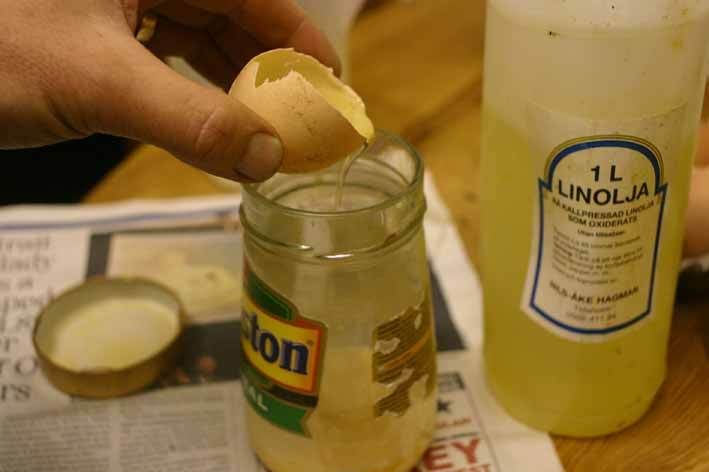
Then put the lid on and shake really well.
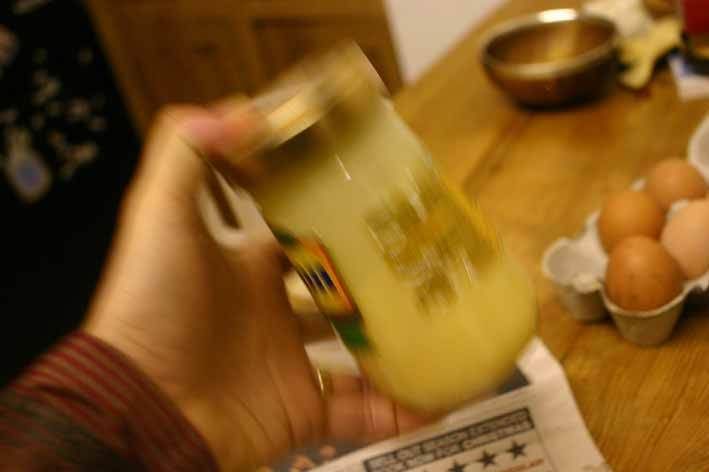
Now add 3 egg volumes (6 half shells) of water, swirling to mix then put lid on and shake. You can use more or less water to make your paint thinner or thicker as ypou wish depending on the absorbency of the substrate. This is now the basic paint without pigment. It can be used to seal woodware for use and I will treat the inside of my bowl with it, this paint mix is also great for sealing dusty lime wash.
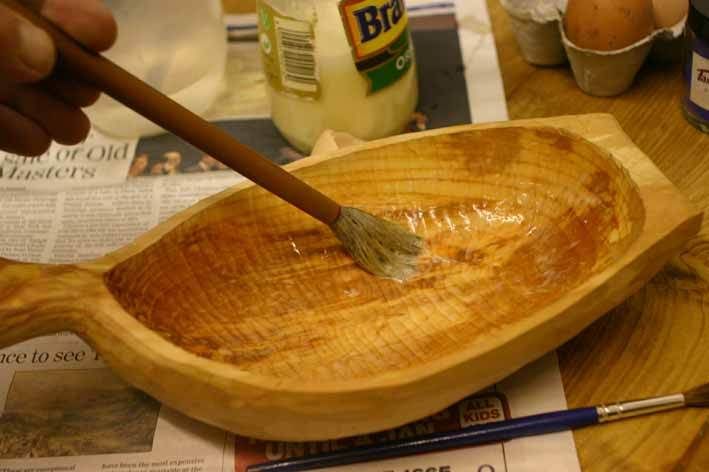
Now I am going to add pigment, this is a ground earth pigment "ultramarinbla" that we bought in Sweden, anyone who has traveled there will have seen houses painted with it. In the UK many art supply places will sell ground pigments also eco paint supply places such as the centre for alternative technology, auro is a brand I have used. You can also gather your own pigment, most fine soft stones can be ground up and used, I collect an orange mineral oxide that oozes out of the shale beds near my home for a nice orange, and also grind the shale for black, they need sieving, drying and grinding before adding the powder to the paint.

These pigments are very concentrated though and a small amount goes a long way. Lime can be added too if you want more pastel tomes.
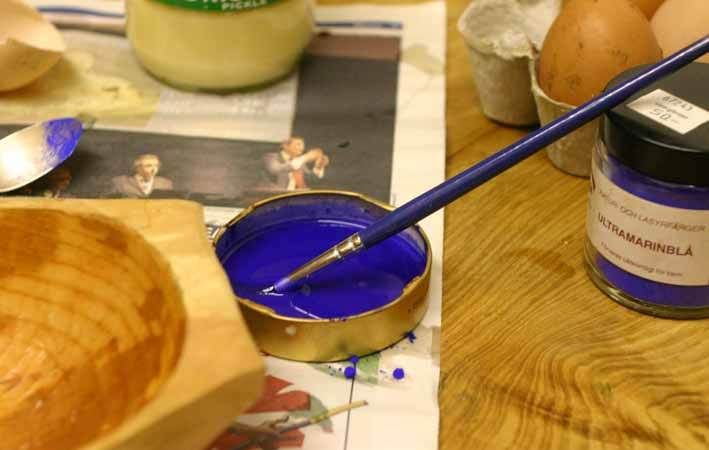
Now slap it on just as if it were commercially bought paint.

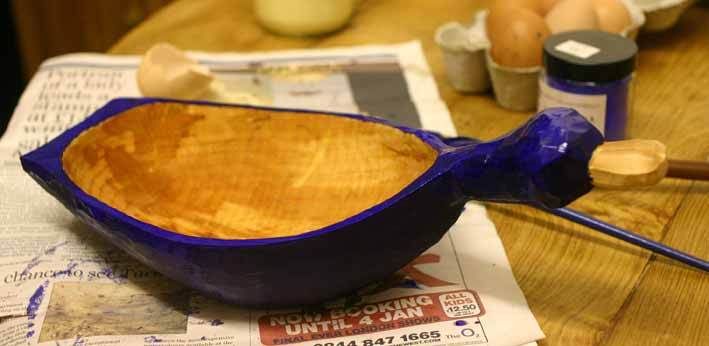
in 20 minutes it is touch dry, less on absorbent substrates.

So that is the good part. Now the drawbacks. Although it is touch dry quickly it is still very soft and can easily be scraped off with a fingernail. It takes a while for the oil to cure, just like a proper old oil painting. How long depends on the oil, it can be a week or two or up to two months before it becomes really hard. Boiled linseed is faster because it has heavy metal driers added, I prefer to wait.
When dry it is quite hard wearing, I have a breakfast bowl painted with this paint that I have washed every day for six years and the paint is still good. It ages beautifully, where a hard modern paint eventually fails by chipping and peeling these soft old paints simply wear through on the highlights where they are rubbed which looks nice.
The paint will not keep long, maybe a week in the fridge. It will not give you a totally flat even colour, the sort of thing we are used to with canned paints these days, it will be a little more variable, I think this is a benefit but some would think otherwise. It is important to make enough to do a whole wall in one go, you don't want to run out and have to mix a bit to match. The one egg quantity would easily do both sides of a door with some to spare.
One of the nicest jobs I did with this paint was using it as a glaze over a white limewash, I mixed it fairly thin with locally collected ochre pigment and sponged it over the limewash, it gave a lovely textured feel. It dries neither matt nor gloss, if you want gloss after it is dry give it a thin coat of pure linseed over the top though that will take a while to dry.
You will need
1 whole egg
linseed oil, I prefer raw cold pressed.
water
jam jar with tight fitting lid.
I am making this batch to paint some wooden bowls I carved a few weeks ago but it is equally good for walls or windows and doors.
So here are my ingredients

First crack your egg into the jar put the lid on and shake it really well. Using half the shell as a measure add two egg volumes of oil (4 half shells) swirl the jar as you pour in the oil to help it mix.

Then put the lid on and shake really well.

Now add 3 egg volumes (6 half shells) of water, swirling to mix then put lid on and shake. You can use more or less water to make your paint thinner or thicker as ypou wish depending on the absorbency of the substrate. This is now the basic paint without pigment. It can be used to seal woodware for use and I will treat the inside of my bowl with it, this paint mix is also great for sealing dusty lime wash.

Now I am going to add pigment, this is a ground earth pigment "ultramarinbla" that we bought in Sweden, anyone who has traveled there will have seen houses painted with it. In the UK many art supply places will sell ground pigments also eco paint supply places such as the centre for alternative technology, auro is a brand I have used. You can also gather your own pigment, most fine soft stones can be ground up and used, I collect an orange mineral oxide that oozes out of the shale beds near my home for a nice orange, and also grind the shale for black, they need sieving, drying and grinding before adding the powder to the paint.

These pigments are very concentrated though and a small amount goes a long way. Lime can be added too if you want more pastel tomes.

Now slap it on just as if it were commercially bought paint.


in 20 minutes it is touch dry, less on absorbent substrates.

So that is the good part. Now the drawbacks. Although it is touch dry quickly it is still very soft and can easily be scraped off with a fingernail. It takes a while for the oil to cure, just like a proper old oil painting. How long depends on the oil, it can be a week or two or up to two months before it becomes really hard. Boiled linseed is faster because it has heavy metal driers added, I prefer to wait.
When dry it is quite hard wearing, I have a breakfast bowl painted with this paint that I have washed every day for six years and the paint is still good. It ages beautifully, where a hard modern paint eventually fails by chipping and peeling these soft old paints simply wear through on the highlights where they are rubbed which looks nice.
The paint will not keep long, maybe a week in the fridge. It will not give you a totally flat even colour, the sort of thing we are used to with canned paints these days, it will be a little more variable, I think this is a benefit but some would think otherwise. It is important to make enough to do a whole wall in one go, you don't want to run out and have to mix a bit to match. The one egg quantity would easily do both sides of a door with some to spare.
One of the nicest jobs I did with this paint was using it as a glaze over a white limewash, I mixed it fairly thin with locally collected ochre pigment and sponged it over the limewash, it gave a lovely textured feel. It dries neither matt nor gloss, if you want gloss after it is dry give it a thin coat of pure linseed over the top though that will take a while to dry.
